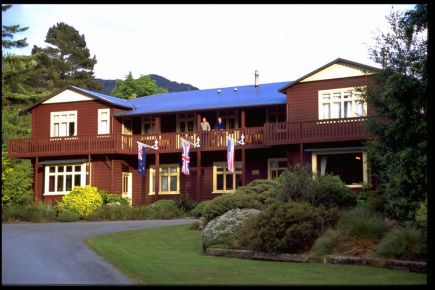History: Accommodation hotel at Lake Rotoroa

Lake Accommodation House. Photo: Supplied.
BY ROBYN PARKES
In May 1923, Alfred Flower secured a lease from the Lands Department for a piece of land at Lake Rotoroa with the intention of building there an accommodation house.
The condition of the lease was that he must spend not less than £3000 and erect a building of not less than 20 rooms by July of the same year.
There were many who thought Flower had taken leave of his senses in going to such expense at such an isolated spot, but with a shrewd mind he had banked on the beauty of the lake and surrounding bush, the clean healthy air, boating, launching, and swimming on the lake to attract large numbers of people seeking a break.
With an assurance from the Roads Board that the road into the lake would be improved and metalled, Flower, with his brother, began the build, planning on a 30-room hotel.
However, no improvements were made on the road which, without good access could threaten the success of the venture.
Flower himself financed the building of a bridge.
The completed accommodation hotel, capable of housing upwards of 60 people, was a large and well-appointed building overlooking the lake and had all the conveniences and luxuries that a traveller would need.
Hot and cold water and electric light was installed in every room. Within three months the Flower brothers had cleared an acre of land and developed a large garden for growing crops of vegetables.
Two landing piers, one near the hotel and one further up the lake, were built with an eye on taking visitors out onto the lake. Their small fleet of pleasure boats comprised of three motor launches (the largest carrying 24 adults), three rowing boats, and two large canoes. Visitors could experience a 25-mile trip around Lake Rotoroa in the larger launch captained by Skipper McConchie, who maintained about a chain from the land all the way, enabling people to enjoy the bush and scenery.
During the 1929 Murchison earthquake, the hotel was badly damaged, and the jetty completely smashed. Witnesses told of how the lake rocked from side to side like a basin of water being tipped about and half an hour after the main shake the water receded from the hotel shore of the lake and exposed the lakebed for about 50 yards. It then came back in a series of large waves. The bridge over the Gowan at the lake, was torn from its piles and was hurled up stream.
The wrecked structure was carried still further by the waters which were temporarily flowing back into the lake.
The water then turned again to its normal course and carried the bridge back against the piles. Slips and fissures on the road between the Gowan bridge and the lake made it impossible to access the hotel. With true grit and determination Flowers had the hotel repaired and a new bridge built, although he had to pay for the bridge as it was deemed to be for private use.
